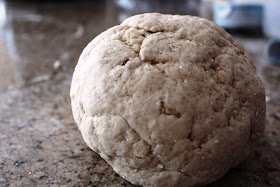Last summer Dan and I went to Savannah, Georgia. Our time there characterized our approach to travel. I had a list of things I wanted to do and see, and I used Yelp like crazy finding the best spots to eat. Dan just wanted to go there and see what there was to see. I've learned to navigate this. I don't over-schedule anything, and I make sure I avoid really touristy areas. I don't like them, anyway. Dan's most happy when we happen upon a great church or cemetery. Put the man in a national park, and he is in heaven. I know this about him, and I'm happy to accommodate. As long as we eat in the good spots.
Aside from how it tastes, Irish brown bread is ridiculously easy to make. It does not require any rise time, and it contains no yeast. It can be made quickly with a food processor, and is finished in less than an hour.
Another benefit is that it
uses common ingredients. I've found that either buttermilk or plain
nonfat Greek yogurt work just as well, so I use whichever I've got in
the fridge. Though the recipe calls for both all-purpose and whole
wheat flour, I've made it with just all-purpose flour when I didn't have
whole wheat flour left in the pantry and it still turns out great.
This bread also does not
require extensive knead time. In fact, just knead it about five times
and it's formed and ready to put on a pan.
It doesn't even require a rolling pin. Just flatten it with your hands until you've got a circle about 7 inches in diameter.
I'm not quite sure why, but the recipe I based my Irish brown bread from instructs the baker to cut an x into the dough before baking it. There is probably some chemistry or culture behind this, but forgive me, I have no idea what it is. I'm just a total rule follower, and therefore, I cut an x in my dough.It seems to work, though.
I've never had this recipe fail. It isn't supposed to look perfect--in fact, it's supposed to look kind of rustic. I love that. It releases my inner perfectionist, and I can just enjoy the final product. (I do actually measure it with a ruler, though, to make sure it's 7 inches. I know. I know. Type A)
I generally cut it into 10 wedges, but only because that's more opportunity for butter. Everyone always takes more than 1 piece. Except me, because I'm terrified of getting diabetes and watch what I eat. (refer to Type A comments)
I have to work hard to be restrained with this bread, too. I could definitely eat half the loaf, with nothing else, for any meal. Try it, and you might just call it a pot o' gold. You might have the luck of the Irish. Or you might just make your family happy. And that's enough for me.
Irish Brown Bread
Adapted from Irish Brown Bread shared by Sunset Magazine
1 c. all-purpose flour
2 T. sugar
1 t. baking soda
1 t. baking powder
1 t. salt
2 T. cold butter
2 c. whole-wheat flour
1/3 c. old-fashioned rolled oats
1.5 c. buttermilk OR plain Greek yogurt
Preheat oven to 375. In a food processor, pulse all-purpose flour, sugar, baking soda, baking powder, salt and cold butter until butter is well incorporated. Add the whole-wheat flour, rolled oats and buttermilk. You could use plain Greek yogurt instead of buttermilk--we've done it both ways and both are great. Pulse the food processor until a ball of dough forms.
Sprinkle about a teaspoon of flour onto the counter, and knead the dough about five times. Form the dough into a ball, then flatten the ball into a 7-inch circle. Cut an x into the top of the dough. Butter about an 8-inch circle on a baking sheet, place the dough on top, and bake for 35 minutes. Remove the bread and allow it to cool for at least a few minutes before slicing it into wedges. Enjoy!


















































